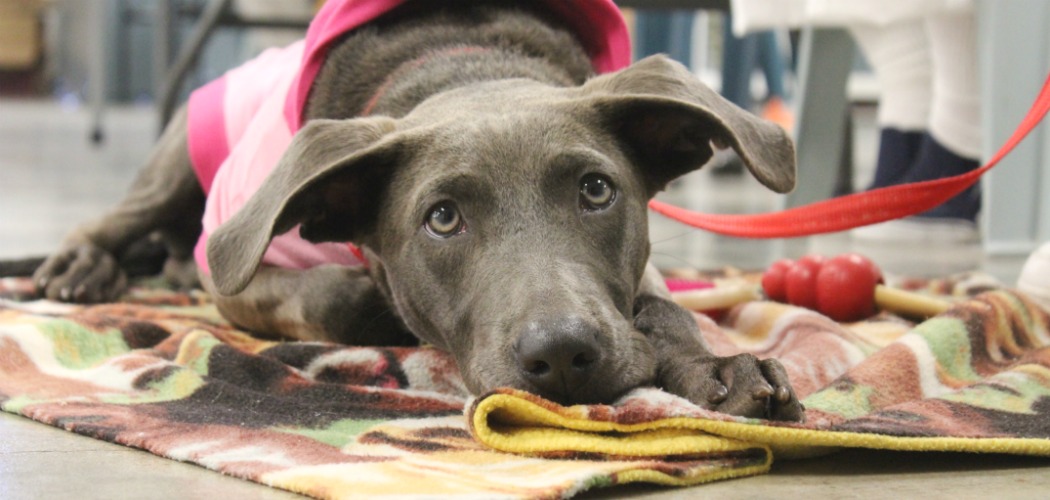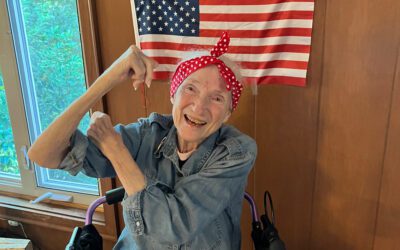[title subtitle=”WORDS and IMAGES Dwain Hebda”][/title]
Lashawnda Macon shakes her head at the harlequin knucklehead lolling at her feet. Tito, a Great Dane mix with a heart as big as his paws, has grown tired of waiting for class to start, taking it out on his cobalt blue leash.
“They always give me the big dogs,” she says, pulling the leash out of Tito’s jaws, a move that only inspires him to take it again, delighted at the impromptu tug-of-war. But what Lashawndagives up in size, she makes up for in voice and with a sharp, “Mama said no!” Tito releases the leash and looks pitifully at his trainer. In prison, everyone walks the line.
Antics and all, Tito is a crowd favorite here at the Hawkins Unit in Wrightsville and he’s not the only one. The other dogs seated with their inmate trainers for today’s Paws in Prison session all, in turn, get their share of attention and fuss, too. It’s a session everyone in the room – human and canine – looks forward to.
“All of them are different,” said inmate Angela Fisher of Jacksonville. “Every single dog I get I say, ‘I cannot love another dog as much as I do this one.’ But another one comes in that needs me and I just fall in love all over again.”
Her current pup, Layla, is a sparky little multi-colored number with bright eyes. During the class, the fluffer demonstrates its mastery of commands, eyes locked with hers.
“Whenever I first came to prison I was going through a lot of mental problems. I became a cutter,” Angela says softly. “When I came to this unit, I was here for a couple years and they brought the dogs. Since I’ve been in the dog program it has just helped me so much. When I’m sad, I just grab ahold of the dog. I can love on the dog.”
Dina Tyler, communications director for the Arkansas Department of Correction, has spent enough time here to know the dogs and their handlers on sight, moving among them like a den mother. There are plenty in the system who live up to the worst stereotypes, but this Paws in Prison group – and ones like it at facilities across the state – represents something different, something hopeful.
“We take dogs that are from shelters, usually high-kill shelters, and many of these dogs have been overlooked because they’re large, or because they’re black, or because they’re not small, cute and fluffy,” she says. “They’ve been overlooked, passed by and their chances of being euthanized run higher.”
“We train them so they have their basic commands down and it gives them an edge. You take a dog that has been passed over and you give the dog skills, suddenly that dog becomes a champion in people’s eyes.”
Paws in Prison came to Arkansas in December 2011, and today operates in six detention centers around the state with another coming online soon. Two inmates are assigned per animal and the pooches live full-time with their trainers inside prison walls for the eight to ten weeks it takes to complete training. The dogs are then put up for adoption through rescue agencies and the inmates take on another hound.
“At this point we’re over 1,400 dogs. It won’t be long before we get to 1,500 that we have put through the program and have been adopted,” Dina says. “To be honest, most of those dogs wouldn’t be alive.”
Like everything on the inside, taking part in the training program is a privilege, contingent upon following the rules. Paws in Prison training does not replace inmates’ work detail and entails day-to-day care of the animal. These extra responsibilities have a rehabilitative effect on participants, says Billy Inman, deputy warden.
“It gives the ladies something to care for,” he says. “Most women are caregivers, so it provides them a purpose and it provides them an opportunity to provide care in the way they need to. It probably helps with our behavior issues; it helps in the barracks in general. There are some folks who don’t feel comfortable around them, but most folks love dogs.”
“They’re also taking responsibility for this animal and it’s an extra thing that they do. That’s probably not been a part of their past, where they’ve taken responsibility for extra things. I think it does give them a sense of giving back. Plus, for some of them it may provide them skills they can use once they get out. Some of our trainers are long-term inmates and it gives them hope and purpose and that’s important.”
It’s not hard to see where that purpose has taken root. Angela describes her dream for opening a dog training facility once she’s released and several former inmates, like Tracy Owen, have found a fresh start at the end of a training leash. Tracy was among the initial group of Paws in Prison trainers at Wrightsville and is now a partner in a successful dog training business, has a line of training treats and volunteers to oversee Paws in Prison programs in various Arkansas units.
“The first eight of us were selected by the warden,” she recalls. “He called us all in and we thought it was a joke. There’s no way they’re going to let us have a dog in prison. We just didn’t believe it.”
“When they brought the dogs, we didn’t know what to do with them. It was so funny; we were in here, they gave us the dog, they sent us out this way and we were back there waiting like, what do you want us to do with the dog? It was pretty cool though.”
Tracy, who estimates she trained over one hundred dogs between the start of the program and her release in 2016, knows well the mutual benefit that the hounds and the inmates share.
“I think a big part of it is that you do relate to them,” she says. “They were locked up basically just like we are and we’re giving them another chance. It was also giving us a way that we could kind of feel like we were making up for the wrongs we had done.”
“Plus, there’s no affection in prison. Even if you lose somebody, hugging, they can write you up for that. There’s no contact. So now all of a sudden you have this animal you can love on and you can brush it and it shows you affection and you can tell it anything and it doesn’t tell anybody else and cause a whole bunch of mess.”
Even after her release, Tracy found salvation in dogs. Most people don’t understand the challenge of re-entry and the PTSD that comes from long-term incarceration. Tracy coped using a service dog when her environment became too much and the walls started closing in. Watching the inmates take their dogs through their paces, it’s not hard to imagine one of these pups doing the same.
“It saves everybody’s life, the inmate’s, the dog’s,” Tracy says, a faraway look in her eye. “And (training’s) a passion. If you are good at it and it’s really in you, you can’t imagine doing something else.”
Victoria Vander Schilden, executive director of the Arkansas Paws in Prison Foundation and the Paws in Prison coordinator for the Department of Correction, says she’s seen remarkable things come from the program.
“There are studies that have been done where the number of health incident reports go down with inmates who are participating in prison dog programs,” she said. “We actually had one inmate who was in a wheelchair and in order to get in the program he started working out and doing his physical therapy and he got up out of the wheelchair so that he could become a trainer.”
“I definitely think it helps from a mental standpoint. I’d also say it brings a sense of normalcy to an environment that is not normal whatsoever. And it teaches them responsibility, which is a huge thing for when they get out.”
The newest Paws in Prison is coming soon to the medium security women’s unit in Newport, a milestone Victoria’s been working toward for years. The very mention of it brings a smile to her face.
“We’ve been working to get the funds in order to make sure that once we open it, we can keep it up and running,” she said. “I think we’ve finally gotten to the point where we’re going to open it up next year.”
Looking on from the sidelines, one can’t help but be impressed to the point of forgetting about the crimes the inmates have committed, some of them violent. This too is a core benefit of the program, giving society a way to see a real person and not just a jumpsuit and a dossier of poor decisions. And, most importantly, to help the inmate see something more, too.
“This program gives me a reason to get up and get dressed and act like I’m supposed to act in here and follow the rules, because if I don’t then they’re going to take this dog away from me,” says Mary Monte, thirty years into a life sentence. “It just makes me a better person in here. It makes me want to do right.”
“After all these years, I still sit on my bed and I say, ‘God, you love me this much that I have a dog in prison.’ I get to go outside and spend time, sometimes by myself, with a dog. You’re never by yourself in prison. It’s a blessing.”
HOW TO HELP
Paws in Prison is always in need of monetary donations and supplies to help keep the animals comfortable and the program going. Dog crates, blankets, food, treats, toys and other items are greatly appreciated and tax deductible.
Donate to the program online via their Facebook page or through PayPal at paypal.com/us/fundraiser/charity/1582652. You can also mail a check to Arkansas Paws in Prison, 6814 Princeton Pike, Pine Bluff, AR, 71602.
Donate supplies via the group’s Amazon WishList: amzn.to/36n27p3. And finally, support the program through Amazon Smile when making other purchases at smile.amazon.com/ch/46-2878307.
To view PIP graduate dogs awaiting forever families and their adopting agencies, visit adc.arkansas.gov/available-dogs.




